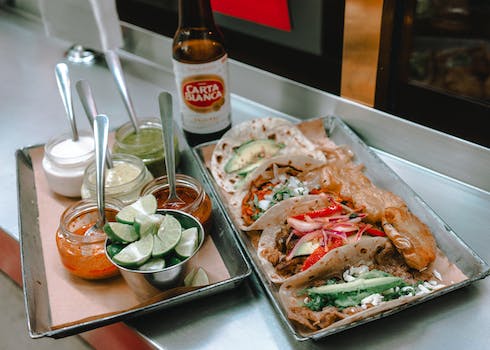

-
Table of Contents
Embrace the New Era: The Rise of Cloud Kitchens
Introduction
The rise of cloud kitchens marks a significant shift in the food industry, as it embraces the new era of technology and convenience. These kitchens, also known as ghost kitchens or virtual restaurants, operate solely for delivery and takeout orders, without any dine-in option. With the increasing demand for online food delivery services, cloud kitchens have gained popularity among both established restaurant chains and aspiring entrepreneurs. This article explores the reasons behind the rise of cloud kitchens and the benefits they offer in this new era of food service.
The Benefits of Cloud Kitchens for Food Entrepreneurs
The rise of cloud kitchens has revolutionized the food industry, offering a new and innovative way for food entrepreneurs to thrive in the digital age. These virtual kitchens, also known as ghost kitchens or dark kitchens, have gained popularity in recent years due to their numerous benefits for food entrepreneurs. In this article, we will explore the advantages of cloud kitchens and how they are transforming the way food businesses operate.
One of the primary benefits of cloud kitchens is the reduced overhead costs. Traditional brick-and-mortar restaurants require significant investments in real estate, interior design, and equipment. On the other hand, cloud kitchens eliminate the need for a physical storefront, allowing entrepreneurs to save on rent and other associated expenses. This cost-saving advantage enables food entrepreneurs to allocate their resources more efficiently, investing in high-quality ingredients and marketing strategies to enhance their offerings.
Moreover, cloud kitchens provide a flexible and scalable business model. With a traditional restaurant, expanding or relocating can be a complex and costly process. However, cloud kitchens offer the flexibility to adapt and grow rapidly. Entrepreneurs can easily set up multiple virtual kitchens in different locations, targeting specific customer segments without the constraints of physical boundaries. This scalability allows food entrepreneurs to experiment with different concepts and menus, catering to diverse tastes and preferences.
In addition to cost savings and flexibility, cloud kitchens also offer increased efficiency. By eliminating the need for a dine-in area and focusing solely on delivery and takeout orders, food entrepreneurs can streamline their operations. This streamlined approach allows for faster order processing and delivery times, enhancing customer satisfaction. Furthermore, cloud kitchens can leverage technology to optimize their processes, such as using data analytics to identify popular dishes and streamline inventory management. This efficiency not only improves the overall customer experience but also maximizes profitability for food entrepreneurs.
Another advantage of cloud kitchens is the reduced risk associated with starting a food business. Opening a traditional restaurant involves a significant amount of risk, as the failure rate is high. However, cloud kitchens provide a lower barrier to entry, allowing aspiring food entrepreneurs to test their concepts and build their brand without the same level of financial risk. This reduced risk encourages innovation and creativity in the food industry, as entrepreneurs can experiment with unique and niche concepts that may not have been feasible in a traditional restaurant setting.
Furthermore, cloud kitchens offer food entrepreneurs access to a wider customer base. With the rise of food delivery platforms and online ordering, consumers have become accustomed to the convenience of ordering food from the comfort of their homes. Cloud kitchens capitalize on this trend by partnering with popular delivery apps, reaching a larger audience and increasing their visibility. This expanded reach allows food entrepreneurs to tap into new markets and attract customers who may not have discovered their offerings otherwise.
In conclusion, cloud kitchens have emerged as a game-changer for food entrepreneurs, offering a range of benefits that traditional restaurants cannot match. From reduced overhead costs and increased flexibility to improved efficiency and reduced risk, cloud kitchens provide a platform for innovation and growth in the food industry. As the digital era continues to shape consumer behavior, embracing the new era of cloud kitchens is essential for food entrepreneurs looking to thrive in the competitive market.
How Cloud Kitchens are Revolutionizing the Food Delivery Industry

The food delivery industry has undergone a significant transformation in recent years, thanks to the rise of cloud kitchens. These innovative establishments have revolutionized the way food is prepared and delivered, offering a more efficient and cost-effective solution for both restaurants and consumers.
Cloud kitchens, also known as ghost kitchens or virtual kitchens, are commercial facilities that are solely dedicated to food preparation for delivery. Unlike traditional restaurants, cloud kitchens do not have a physical dining area or storefront. Instead, they focus solely on the production of food, which is then delivered to customers through various online platforms.
One of the key advantages of cloud kitchens is their ability to reduce overhead costs. Traditional restaurants often face high expenses associated with rent, utilities, and staffing. In contrast, cloud kitchens can operate in smaller, more affordable spaces, as they do not require a dining area. This allows them to allocate more resources towards quality ingredients and efficient food production processes.
Furthermore, cloud kitchens can optimize their operations by strategically locating their facilities. By setting up in areas with high demand and low competition, they can maximize their reach and minimize delivery times. This not only improves customer satisfaction but also enables them to serve a larger customer base without the need for multiple physical locations.
Another significant benefit of cloud kitchens is their flexibility. Traditional restaurants are often limited by their physical space and capacity. They may struggle to accommodate sudden surges in demand or adapt to changing consumer preferences. Cloud kitchens, on the other hand, can easily scale their operations up or down based on demand. This agility allows them to quickly respond to market trends and offer a wider variety of cuisines and menu options.
Cloud kitchens have also embraced technology to streamline their operations. They leverage advanced ordering and delivery management systems to efficiently process and fulfill customer orders. This not only improves order accuracy but also reduces delivery times, ensuring that customers receive their meals promptly. Additionally, cloud kitchens can collect and analyze data on customer preferences and ordering patterns, enabling them to personalize their offerings and enhance the overall customer experience.
The rise of cloud kitchens has also been fueled by the increasing popularity of food delivery services. With the convenience of ordering food online and having it delivered to their doorstep, more and more consumers are opting for this hassle-free dining experience. Cloud kitchens have capitalized on this trend by partnering with popular delivery platforms, making it easier for customers to access their offerings.
However, it is important to note that cloud kitchens are not without challenges. As they rely heavily on technology and online platforms, they are vulnerable to technical glitches and disruptions. Additionally, the lack of a physical dining area means that cloud kitchens may struggle to build a loyal customer base and establish a strong brand presence.
In conclusion, cloud kitchens have emerged as a game-changer in the food delivery industry. By leveraging technology, optimizing operations, and embracing flexibility, they have revolutionized the way food is prepared and delivered. While they face certain challenges, their ability to reduce costs, adapt to changing demands, and enhance the customer experience makes them a force to be reckoned with. As the food delivery industry continues to evolve, cloud kitchens are poised to play a pivotal role in shaping its future.
The Future of Dining: Exploring the Growth of Cloud Kitchens
The dining industry has undergone a significant transformation in recent years, with the rise of cloud kitchens emerging as a prominent trend. These virtual restaurants, also known as ghost kitchens or dark kitchens, have revolutionized the way food is prepared and delivered to customers. In this article, we will explore the growth of cloud kitchens and the implications they have for the future of dining.
Cloud kitchens are essentially commercial cooking spaces that operate solely for delivery purposes. Unlike traditional restaurants, they do not have a physical dining area for customers to sit and eat. Instead, they focus solely on preparing food for delivery or takeout. This model has gained popularity due to the increasing demand for food delivery services and the convenience they offer to both customers and restaurant owners.
One of the main advantages of cloud kitchens is their cost-effectiveness. By eliminating the need for a physical dining space, restaurant owners can significantly reduce their overhead expenses. This includes rent, utilities, and staffing costs. With the rise of online food delivery platforms, cloud kitchens can operate with a smaller team of chefs and delivery personnel, further reducing labor costs. This cost-efficiency has made cloud kitchens an attractive option for entrepreneurs looking to enter the food industry without the high upfront investment required for a traditional restaurant.
Another key benefit of cloud kitchens is their flexibility. With a traditional restaurant, owners are limited by the location and size of their physical space. However, cloud kitchens can be set up in any location with adequate infrastructure and can easily be scaled up or down based on demand. This flexibility allows restaurant owners to experiment with different cuisines or concepts without the risk of committing to a long-term lease or extensive renovations. It also enables them to quickly adapt to changing consumer preferences and market trends.
The rise of cloud kitchens has also been fueled by advancements in technology. With the increasing popularity of food delivery apps, cloud kitchens can easily reach a wider customer base without the need for extensive marketing efforts. These platforms provide a convenient way for customers to discover and order from a variety of virtual restaurants in their area. Additionally, cloud kitchens can leverage data analytics to gain insights into customer preferences and optimize their menu offerings. This data-driven approach allows them to tailor their offerings to specific target markets and increase customer satisfaction.
However, the growth of cloud kitchens has not been without challenges. One of the main concerns is the lack of face-to-face interaction between customers and restaurant staff. While this may not be an issue for some customers who prioritize convenience, others may miss the personal touch and ambiance of a traditional dining experience. Additionally, the reliance on third-party delivery platforms can lead to increased fees and reduced profit margins for cloud kitchens. To mitigate these challenges, some cloud kitchens have started to offer pickup options or partner with delivery services that offer lower commission rates.
In conclusion, cloud kitchens have emerged as a game-changer in the dining industry. Their cost-effectiveness, flexibility, and ability to leverage technology have made them a popular choice for restaurant owners and customers alike. While there are challenges to overcome, the rise of cloud kitchens signals a new era in dining, where convenience and innovation take center stage. As the industry continues to evolve, it will be interesting to see how cloud kitchens shape the future of dining.
Q&A
1. What are cloud kitchens?
Cloud kitchens are commercial cooking facilities that are specifically designed for delivery-only food businesses. They operate without a physical dining space and focus solely on preparing food for delivery or takeout.
2. Why are cloud kitchens becoming popular?
Cloud kitchens are gaining popularity due to several reasons. They offer lower startup costs compared to traditional restaurants, as there is no need for a physical dining area. They also provide flexibility for food entrepreneurs to experiment with different concepts and menus. Additionally, the rise of online food delivery platforms has increased the demand for cloud kitchens.
3. What are the benefits of cloud kitchens?
Cloud kitchens offer several benefits, including reduced overhead costs, as there is no need for a storefront or dining area. They also provide increased efficiency in food preparation and delivery, as they are designed specifically for this purpose. Cloud kitchens also allow for easy scalability and expansion, as they can be set up in various locations to cater to different customer bases.
Conclusion
In conclusion, the rise of cloud kitchens represents a significant shift in the food industry, as it embraces the new era of technology and convenience. These virtual restaurants offer numerous benefits, such as reduced overhead costs, increased efficiency, and expanded market reach. With the growing demand for food delivery and the advancements in digital platforms, cloud kitchens are poised to revolutionize the way we dine and cater to changing consumer preferences. As the trend continues to gain momentum, it is likely to reshape the restaurant landscape and create new opportunities for entrepreneurs and food businesses alike.












